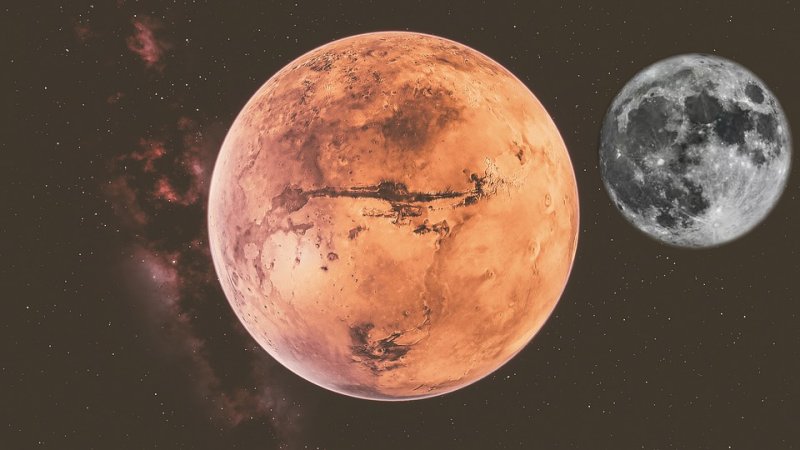Surprising Science From NASA’s InSight Mars Mission
Eddie Gonzales Jr. – MessageToEagle.com – During its first year dedicated to looking deep beneath the Martian surface, NASA’s InSight lander mission delivered many findings that reveal a planet alive with quakes, dust devils and strange magnetic pulses.
InSight lander’s science tools include a seismometer for detecting quakes, sensors for gauging wind and air pressure, a magnetometer, and a heat flow probe designed to take the planet’s temperature.
 In this artist’s concept of NASA’s InSight lander on Mars, layers of the planet’s subsurface can be seen below and dust devils can be seen in the background. Credits: IPGP/Nicolas Sarter
In this artist’s concept of NASA’s InSight lander on Mars, layers of the planet’s subsurface can be seen below and dust devils can be seen in the background. Credits: IPGP/Nicolas Sarter
Mars trembles more often — but also more mildly — than expected.
The ultra-sensitive seismometer, SEIS (Seismic Experiment for Interior Structure) has found more than 450 seismic signals to date, the vast majority of which are probably quakes. The largest quake was about magnitude 4.0 in size — not quite large enough to travel down below the crust into the planet’s lower mantle and core.
SEIS has enabled scientists to “hear” multiple trembling events from hundreds to thousands of miles away.
Those are “the juiciest parts of the apple” when it comes to studying the planet’s inner structure, said Bruce Banerdt, InSight principal investigator at JPL.
It took months after InSight’s landing in November 2018 before they recorded the first seismic event. By the end of 2019, SEIS was detecting about two seismic signals a day, suggesting that InSight just happened to touch down at a particularly quiet time.
 A cutaway view of Mars showing the InSight lander studying seismic activity. Credit: J.T. Keane/Nature Geoscience
A cutaway view of Mars showing the InSight lander studying seismic activity. Credit: J.T. Keane/Nature Geoscience
Scientists still have their fingers crossed for “the Big One.” Mars doesn’t have tectonic plates like Earth, but it does have volcanically active regions that can cause rumbles. A pair of quakes was strongly linked to one such region, Cerberus Fossae, where scientists see boulders that may have been shaken down cliff sides.
Ancient floods there carved channels nearly 800 miles (1,300 kilometers) long. Lava flows then seeped into those channels within the past 10 million years. Some of these young lava flows show signs of having been fractured by quakes less than 2 million years ago.
See also:
NASA’s InSight Will Provide Daily Weather Reports For Planet Mars
Successful Landing Of NASA’s InSight Spacecraft On Mars
NASA’s InSight Spacecraft Approaches Mars
InSight’s Landing On Mars: First Mission Dedicated To Studying Deep Interior Of Mars
InSight Lander On Its Way To Red Planet
“It’s just about the youngest tectonic feature on the planet. The fact that we’re seeing evidence of shaking in this region isn’t a surprise, but it’s very cool.” planetary geologist Matt Golombek of JPL said.
Billions of years ago, Mars had a magnetic field. It is no longer present, but it left ghosts behind, magnetizing ancient rocks that are now between 200 feet (61 meters) to several miles below ground.
InSight is equipped with a magnetometer – the first on the surface of Mars to detect magnetic signals. It has found that the signals at Homestead hollow are 10 times stronger than what was predicted based on data from orbiting spacecraft that study the area.
In addition, scientists are intrigued by how these signals change over time. The measurements vary by day and night; they also tend to pulse around midnight.
InSight measures wind speed, direction, and air pressure nearly continuously, offering more data than previous landed missions. The spacecraft’s weather sensors have detected thousands of passing whirlwinds, which are called dust devils when they pick up grit and become visible.
“This site has more whirlwinds than any other place we’ve landed on Mars while carrying weather sensors,” said Aymeric Spiga, an atmospheric scientist at Sorbonne University in Paris.
Despite all that activity and frequent imaging, InSight’s cameras have yet to see dust devils. But SEIS can feel these whirlwinds pulling on the surface like a giant vacuum cleaner.
“Whirlwinds are perfect for subsurface seismic exploration,” said Philippe Lognonné of Institut de Physique du Globe de Paris (IPGP), principal investigator of SEIS.
InSight has two radios: one for regularly sending and receiving data, and a more powerful radio designed to measure the “wobble” of Mars as it spins.
Written by Eddie Gonzales Jr. – MessageToEagle.com Staff










